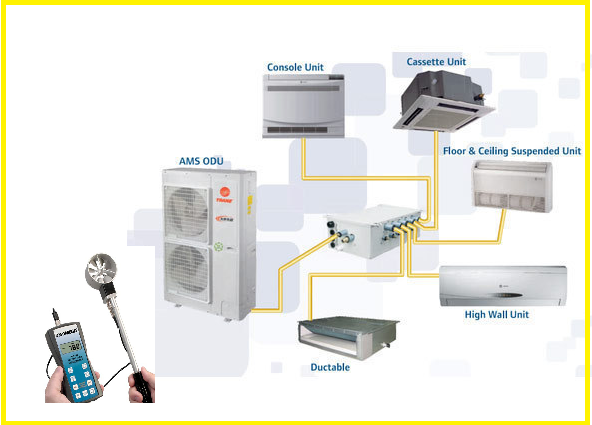Variable Refrigerant Flow (VRF) is also a kind of multi split air conditioner where in single outdoor unit caters the condensing load of all indoor units. Performance of such systems will also be evaluated in terms of EER or Energy Efficiency Ratio. EER is defined as the ratio of cooling capacity in watts to electrical input in Watts.
EER = Cooling Capacity in Watts
Electrical Power Input in Watts
Variable Refrigerant Flow systems have inverter controlled compressor system where the variation in load will be very high and practically evaluating exact efficiency/ performance is little difficult. Any how, EER ( Energy Efficiency Ratio) or performance of an VRF can be evaluated by operating the entire system at full load capacity.
Denominator value Electrical input power can be measured with the help of any energy meter or power analyser. Now finding the cooling capacity actually delivered by the system will be relatively difficult. Cooling capacity generally in chiller systems can be found by measuring chiller water flow rate and temperature differences across evaporator.But in case of VRF systems there are multiple indoor units and measurement of enthalpies is difficult. And as the VRF system uses directly refrigerant itself for heat transfer measuring refrigerant flow becomes practically difficult.
Hence an alternate method of evaluation has to be approached which cannot be as accurate as refrigerant flow method but still can give an fair performance value. In this method load at condenser side near outdoor unit is calculated and cooling load is calculated accordingly.
In this method dry bulb temperatures and wet bulb temperatures both at suction and discharge has to be measured at outdoor unit. With the help of these values from psychrometric charts find enthalpies both at inlet and out let of the outdoor unit and let's call them as H1 & H2.( KJ/KG)
Next with the help of vane type anemometer measure the air velocity which is in m/sec and then multiply this with condenser unit fan area and with density of air to obtain mass flow rate of air in M (kg/hr).
Now with the help of below formula cooling capacity can be calculated
Condenser Load (kcal/hr) = M x (H1 - H2)
4.18
Now convert kcal/hr to kW by dividing with factor 860.
Since Cooling load + Compressor power = Condenser Load
Cooling load = Condenser Load - Compressor Power
Now divide obtained cooling load with the help of measured electrical power which is EER.
This EER value has to be compared with the rated EER value specified by the OEM and can check the deviation.
Since the electrical input power to the compressor changes very dynamically due to change in cooling load and inverter control, EER values for different loading percentages can be evaluated separately like at 25%, 50%, 75% and 100%.
Even seasonal EER can also be calculated and find the performance of the variable refrigerant flow system considering all seasons






Very interesting article. Is it possible to give us a quick schematic view on where we must measure temperatures on suction and discharge at outdoor unit?
ReplyDeleteHi,
ReplyDeleteI read your article and your information are great and amazing. it is so much helpful.
Good information. Thank you. Can you mentioned approximate EER for VRF for calculation of electricity consumption. in general purpose applications'
ReplyDelete